Sonora
by Don Bailey from Don Bailey, State and Federal Copper And Brass Coinage Of Mexico (1824 – 1872), Don Bailey Institute for Mexican Numismatic & Historical research, 2008
When the state of Occidente was divided into Sonora and Sinaloa a new mint was opened at Hermosillo, Sonora. There were two types of coins issued at this mint.
Arrow and Quivers
The first type is the "Arrow and Quivers" and it has for the obverse, an arrow with quivers on each side. The legend around is "EST. D. SONORA UNA CUART". The reverse has the liberty cap and rays, with the legend around, "HERMOSILLO A DE." and the date and "L. S." for Leonard Santoyo, the mint master. The arrow and quivers design was issued in ¼ real denomination only, and in the years 1832 through 1836.
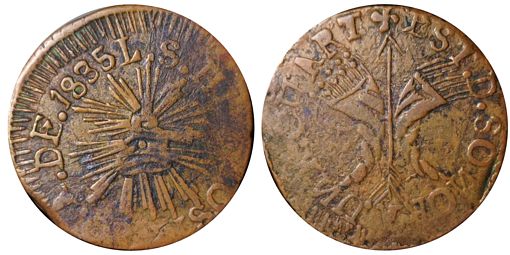
KM 364 ¼ real 1835 Sonora (Del Bosque, Briggs & Bustos Auction #12, 16 October 2020, lot 156)
| KM 364 | Arrow and quivers | 1832 | 21mm | |
| 1833 | ||||
| 1833/2 | ||||
| 1834 | ||||
| 1835 | ||||
| 1835/3 | ||||
| 1836 | ||||
| KM 364a | Various 1/16 counterstamped revaluation |
Leonardo Santoyo, who had been in charge of the Occidente mint, moved to Hermosillo and on 3 May 1831 was granted a concession[text needed] to strike copper cuartillas. The initial concession was to be for 64,000 pieces but it was soon increased to a total authorization of about two million piecesThe local congress authorised the coining by a decree of 23 April 1831[text needed], and then renewed their approval year after year. Thus, on 14 April 1834 they approved[text needed] the minting of coins from June 1834 to March 1835.. Pradeau estimated the actual production to be 540,000 pieces. The poor quality of the Santoyo period coinage poses a problem. Such large quantities of poor quality material bring to question, what was their origin? Were all of these poor quality coins mint products too? Experience shows that there exist more poor quality coins than good. Sorne Hermosillo students believe Santoyo was simultaneously producing fakes outside the mint. Most catalogs list the 1831 cuartilla as the first date of the series but it is probably a circulating counterfeit.
The mint was officially closed in January 1836 but the coins dated 1837, 1838 and 1840 exist and must be considered false. Some or all of the 1836 may also be false. The coinage of the Santoyo cuartillas may have continued surreptitiously in a cave at Guaymas, Sonora. Sorne years ago the late Erma Stevens gave me a strip of metal from which coin blanks had been stamped, which was found in a Guaymas cave along with some coins (mostly defective) and other coining materials. From the quality of the materials found, it was her opinion that the original mint was being operated in a clandestine manner.
The Law of 7 January 1837[text needed] caused the overproduced copper coins to be devalued by one half. On 23 July 1837 the Governor of Sonora, Manuel Gándara, ordered[text needed] the devaluation of the local currency, marking each coin with a counterpunch of lower face value. No actual ⅛ counterstampings are known but some of the coinage of the period is found with a 1/16 revaluation.
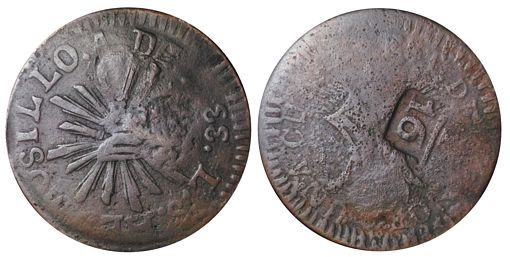
KM 364 ¼ real 1833 Sonora with 1/16 counterstamp (Del Bosque, Briggs & Bustos Auction #12, 16 October 2020, lot 155)
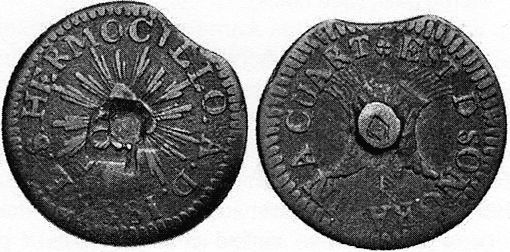
KM 364 ¼ real Sonora 1/16 revalidation cancelled
1837, 1838 and 1840 are circulating counterfeits
For some time after the closing of the Hermosillo mint in January 1836 no Sonora coinage was officially minted. On 16 February 1842, a Presidential proclamation[text needed] authorized the resumption of the Hermosillo (and Alamos) mints but it was not until 1851 that it was leased by the state.
Ignacio Pesqueira, the governor of Sonora, on 7 December 1860, belatedly announced to the Sonora legislature that he had contracted with the Hermosillo mint to coin copper money at face value to replace copper already in circulation. This was a necessary step since large quantities of counterfeit money were being circulated. All were to be exchanged at face value including counterfeits.
The new cuartilla coinage of 1859 was struck at the Culiacán mint as the Hermosillo mint did not yet have a federal authorization to begin operationsPradeau. op. cit. pp. 51- 52.. It is thought that some of the 1861 mintage was also struck at the Culiacán mint. There are no known differences in the coinage to identify the separate mints; however, most of the 1859 issue has dots before and after the date. Note that most of the Sinaloa 1859 issue also has dots before and after the date. Also note that some issues exist without the dots but are scarce. Two of the overdate issues, 1861/59 and 1862/9 lack dots at the date but another has dots before and after the date. Most of the 1861-63 issues lack these dots. Could there be any relationship of the coins with dots and place of origin?
Seated Liberty
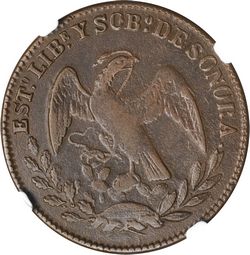
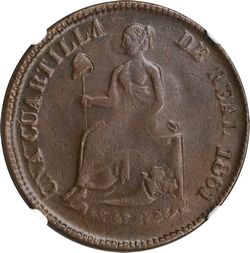
KM 365 ¼ real 1861 Sonora (Stack’s Bowers Baltimore auction, 6 November 2013, lot 23507)
The second type was the "Seated Liberty" design, which has on the obverse the national eagle with the legend, "EST. LIBE Y SOBO DE SONORA", with the reverse showing a seated liberty holding a staff with a liberty cap at its peak. The legend around is "OCTAVO DE REAL" (⅛) and the date, or "UN QUARTO DE REAL", (¼) and the date.
The 1859 issue of the ⅛ real is 28mm and is rare. In 1836, the mint closed and the mintage contract went to the Culiacan mint. The ¼ real, in a 32mm size, was struck in 1859 and 1861 through 1863. The 1859 and 1861 were struck at the Culiacan mint, while Hermosillo also struck 1861's as well as 1862 and 1863. There is no way to distinguish the 1861's mintage, as there are no mintmarks. The edges on these coins are reeded.
| KM 365a | EST. LIBE Y SOBO DE SONORA | 1859 | 32mm | dots at date |
| KM 365b | no dots at date | |||
| KM 365a | dots at date | |||
| 1861 | dots at date |
|||
| 1862 | ||||
| KM 365c | 1862/9 | repunched date | ||
| KM 365d | 1863/2 | |||
| KM 365e | 1863/3 | over inverted 3 |
The large cuartilla issue of 1859-1863 may have totaled over five million pieces. The total population of Sonora in 1869 was estimated to be fewer than 90,000 people, mostly Indians. By 1862 copper coins had declined in value to 60 cents on the dollar. State officials refused to accept copper in payment of taxes, demanding gold and silver only.
According to the Law of 19 May 1863[text needed], copper coinage was to be amortized to remove enough from circulation so that it would be valued with respect to silver. Twenty percent of the Guaymas customs duties were assigned to this amortization. This proved unsuccessful due to other demands on these duties. In addition these duties belonged to the federal government, but it lacked the power to collect them. On 19 June 1867 the governor issued a decree for a compulsory loan from merchants to remove copper coins from circulation.
Mintages
| ⅛ real No. of coins |
¼ real No of coins |
Total value | |
| 1859 | 133,128 | 133,128 | $50.000.00 |
